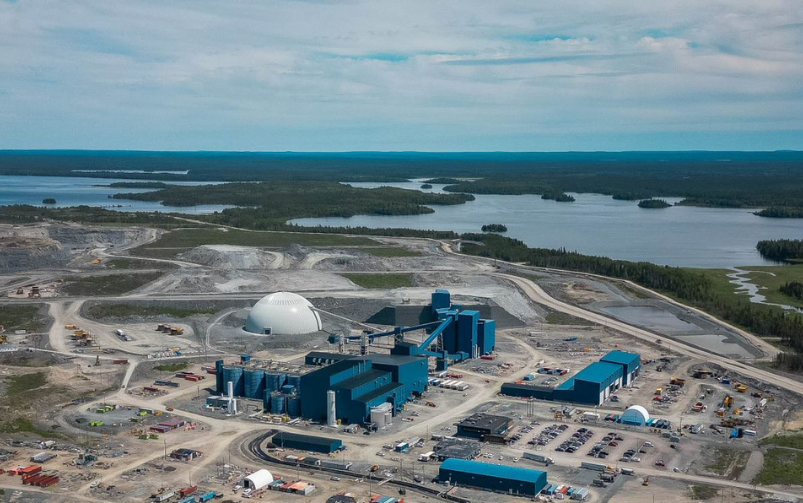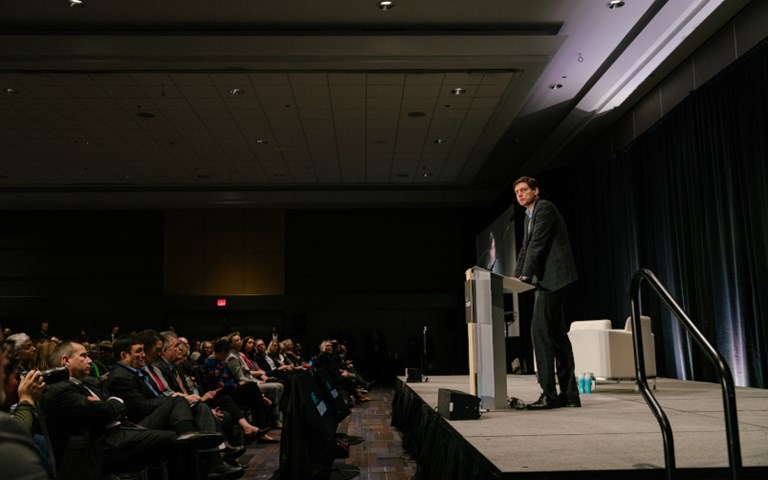B.C. Premier David Eby shared at the opening of the 2024 Association for Mineral Exploration Roundup conference that in 2023, mineral exploration expenditure in the province was $643.5 million, 94.1 per cent higher than in 2018. Courtesy of of the Association for Mineral Exploration
When B.C. Premier David Eby spoke at the opening keynote on Jan. 22 at the Association for Mineral Exploration (AME) Roundup conference, he made a strong statement after unveiling the first phase of the province’s new critical minerals strategy.
“The world needs a stable, free, democratic, high-standard producer of the metals and minerals needed to battle climate change,” Eby told the crowd. “That gives B.C. a generational opportunity to seize, one where we can be prosperous and protect the planet for our kids at the same time.”
As a mining jurisdiction that has reserves of, or produces, 16 of Canada’s 31 critical minerals, and is Canada’s largest copper producer, the province stated that phase one of the critical minerals strategy is its attempt to take advantage of the clean energy transition.
The first phase includes 11 action points, such as the creation of a B.C. critical minerals atlas to provide “world-class geoscience data,” and an alignment of the provincial strategy and the First Nations Energy and Mining Council’s critical minerals strategy, which was released on March 4 of this year. In addition, it includes continuing a commitment to engage with First Nations across the province and also to ensure what it calls “the highest” environmental, social and governance (ESG) standards. The strategy comes after the provinces of Quebec, Ontario, Saskatchewan and Manitoba—as well as the federal government—have all launched respective critical minerals strategies over the past few years.
In a Jan. 22 news release, Josie Osborne, the B.C. energy minister, said that securing critical minerals will help “drive growth and create new jobs for people across the entire value chain of critical minerals.” The steps outlined in phase one go beyond development to also focus on growing downstream opportunities, such as processing, manufacturing and battery recycling, which will recycle mined materials and reintegrate them into the supply chain. No further details on these initiatives have been released so far.
While phase one of the strategy emphasizes the province’s commitment to First Nations on critical minerals development through partnerships and engagement, it stated that the next steps of the strategy will include specific actions such as support for First Nations’ capacity building to develop and refine policy actions, and ensure that the strategy aligns with the UN Declaration on the Rights of Indigenous Peoples. This is particularly important
following the ongoing legal developments regarding the province’s mineral staking system and Indigenous consultations.
But miners have raised concerns about phase one of the strategy, and feel that it does not do enough to ensure the province’s critical minerals supply is competitive. Keerit Jutla, president and chief executive officer of AME, told CIM Magazine in an interview that the provincial government must recognize that B.C. is competing not only with mining jurisdictions outside of Canada but within the country’s borders as well.
“We’re competing internally with Quebec, Ontario and other jurisdictions, so it’s essential that we get a critical minerals fund that matches that type of investment, if not exceeds it,” he said. “We’ve heard domestically and internationally that countries [in Europe and Asia] are looking to Canada for the critical minerals supply chain. So we need to ensure that we have those key drivers there to ensure that we remain competitive on the world stage.”
Much of this concern from the B.C. mining industry has been around the lack of regulatory and financial incentives included in phase one of the strategy. Some want to see a clear focus on fiscal measures from the provincial government to deliver on a robust strategy.
“In 2023, B.C.’s contribution to the national mineral exploration expenditure decreased by 33 per cent for a total contribution lagging at 17 per cent, [compared to] Ontario and Quebec at 24 per cent and 23 per cent, respectively,” Jutla said. “We believe an investment of at least $50 million over three years is required to sufficiently fund and implement a strategy that’s at the same level as our provincial peers. We see what’s working in other jurisdictions here in Canada and we need to take note and apply those best practices.”
The Mining Association of B.C. (MABC) has similar concerns and noted that the government needs to put a competitive fiscal policy in place, which it said phase one of the strategy fails to address. MABC president and CEO Michael Goehring expressed concerns about the province’s current fiscal policies, specifically its new output-based carbon pricing system (OBPS), which is slated to come into effect in April. In
a Jan. 22 statement from the MABC, Goehring pointed out that while B.C. currently pays the highest carbon tax in Canada and also globally “while having the lowest GHG emissions globally,” the technology needed to help reach decarbonization goals—zero-emission haul trucks—will not be available until the end of the decade at the earliest.
“Changes to B.C.’s tax regime over the past 10 years have significantly increased operating costs across the sector,” Goehring stated. “It’s imperative existing and prospective critical mineral mines in B.C. pay a carbon tax that is competitive with Ontario and Quebec. If not, the OBPS will negatively impact investment decisions in B.C. and undermine the goals of the provincial government’s critical minerals strategy.”
Mining industry associations believe that improving fiscal competitiveness could not only bolster the province’s standing among Canadian jurisdictions, it could also help unlock billions of potential revenue in new mining developments.
This comes on the heels of a new study by the MABC that estimated that 14 proposed critical minerals mines, along with two proposed mine extensions, could generate nearly $800 billion over several decades. According to the study, the proposed critical minerals mines represent $36.5 billion in near-term investment in development and construction, $10.9 billion in tax revenues and more.
Mining industry associations are already looking ahead to phase two of the strategy, with the hopes that it will address some of the perceived gaps. The province has not released a timeline for phase two.
“I think all of us are looking at the phase one announcement as a good first step and a good demonstration of intent to provide strong support for the critical minerals industry here in B.C.,” Jutla explained. “But that is really hinging on the expectation of a solid delivery: [that] will be key to honour and to validate [that] optimism. Now that’s back in the government’s court and we hope they’ll deliver something strong for B.C.”




